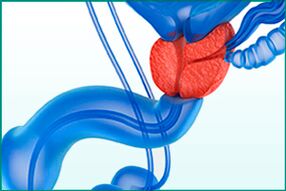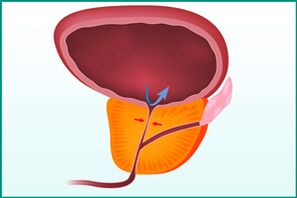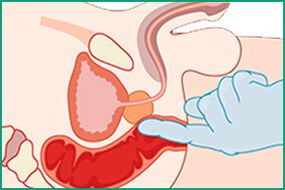Prostatitis is a common urological disease that can occur in any man over the age of 30, and every year the probability of its development only increases. This disease provokes serious problems in men: acute prostatitis leads to depression, decreased libido, and a general disturbance of the genitourinary system; a chronic condition causes diseases of the urological sphere, infertility, impotence.
Main information
Prostatitis is an inflammatory disorder of the prostate gland, an organ found only in men. The iron performs three most important features:
most important features:
- secretory - produces a special enzyme that regulates the viscosity of sperm and ensures the viability of male germ cells for successful fertilization of the egg;
- engine - controls the muscle tissue of the urethral sphincter, due to which the correct process of urine outflow takes place and the secretion of the prostate is released during ejaculation;
- barrier - prevents the penetration of infectious agents into the upper urinary tract from the urethra, provides an antibacterial barrier, as part of the male immune system.
In prostatitis, the prostate gland enlarges and begins to press the urethra, which disrupts the normal flow of urine. The organ itself, due to inflammation, is unable to perform its functions to the greatest extent.
The reasons
The source of health problems in men - prostatitis - can develop due to the following reasons:
- The presence of congestion in the pelvis. Most often, such blood stagnation occurs due to a sedentary, sedentary lifestyle and excess weight.
- Infectious infection of the prostate. It can be descending (through the urine) or ascending (through the urethra), entering the prostate together with blood or lymph.

The development of prostatitis usually occurs against the background of the presence of certain risk factors:
- lack of physical activity;
- maintaining a sedentary lifestyle;
- irregular sex life;
- hypothermia, especially involving the pelvis;
- the presence of injuries in the pelvis;
- weakened immunity;
- malnutrition with an abundance of sweet, fatty and fried foods;
- the presence of bad habits;
- infection with sexually transmitted infections.
Kinds
According to ICD-10 (International Classification of Diseases), 4 types of prostatitis are distinguished:
- Acute prostatitis.
- Chronic bacterial prostatitis.
- Chronic prostatitis is non-bacterial, inflammatory and non-inflammatory.
- Chronic prostatitis, asymptomatic.
In the acute form of the disease, the symptoms appear strongly and clearly, the inflammatory process develops rapidly. Common causes are infection of the prostate gland with infectious agents entering the urethra or blood.
Chronic bacterial form - acute prostatitis that was not cured in time. The development of the pathological condition is facilitated by the same factors that affect acute inflammation - infections of the genitourinary system and blood stagnation in the pelvic organs.
Nonbacterial chronic prostatitis (also called chronic pelvic pain syndrome) occurs most often in older men. It can develop both against the background of impaired functioning of the prostate, and as a result of an autoimmune reaction of the body.
Chronic asymptomatic prostatitis is an inflammation of the prostate gland in which patients do not experience any unpleasant sensations.
Clinic
The clinical picture of acute prostatitis has many vivid manifestations that cannot be ignored and are very difficult to live with:
- increase in body temperature above 38 ° C;
- chills with sweat and weakness;
- severe pain in the lower abdomen, perineum, genitals;
- urination disorder - difficult, painful, acute retention of urine.
With the problem of chronic prostatitis, similar but less pronounced symptoms appear, which are often overlooked:
- dull pain in the perineum and lower abdomen, radiating to the sacrum and genitals;
- difficult urination, painful and fast with imperative (sharp and irresistible) urges, most often at night;
- erectile dysfunction;
- decrease in the quality and duration of intercourse;
- reducing the severity of orgasm.
The asymptomatic course of prostatitis occurs without complaints from the patient. The problem is discovered incidentally during examination of the prostate and/or urine.
Diagnostic methods
If prostatitis is suspected, the doctor conducts diagnostics, the first step of which is to clarify the complaints and study the medical history. Information is collected on all symptoms and their development. The following activities follow:

- Palpation of the prostate through the rectum to determine the size of the organ, its density and soreness. For further bacteriological analysis in the probing process, the secret of the gland is also collected. The purpose of the examination is to rule out a number of diagnoses: prostate adenoma or cancer, rectal cancer.
- Ultrasound and TRUS to complement and clarify the data obtained during palpation.
- Bacteriological analysis of prostate secretion to detect infection and determine the type of pathogens. Data are needed to select and prescribe antibiotics.
- A blood test to determine the level of PSA (prostate specific antigen) - allows you to rule out adenoma and cancer of the gland.
- Biopsy - examination of a sample of prostate tissue under a microscope to confirm or rule out adenoma and cancer.
Treatment
Modern urology considers three types of treatment of acute prostatitis and exacerbation of the chronic form of the disease:
- medicines;
- surgical;
- physiotherapy.
Drug exposure includes taking antibiotics from the groups penicillins, fluoroquinolones, macrolides, tetracyclines, cephalosporins or aminoglycosides. The specific drug is prescribed by the doctor depending on which infectious agent provoked the inflammation. In addition, patients are prescribed:
- anti-inflammatory drugs to eliminate fever;
- pain relievers;
- antispasmodics to normalize the flow of urine;
- alpha blockers to relieve symptoms and restore healthy urination.
In the absence of an effect from the drugs or in advanced cases of acute prostatitis, the doctor may prescribe a surgical intervention in which the entire prostate gland or part of it is removed. The operation is necessary in patients with concomitant problems: stones in the prostate or neoplasms of a benign and malignant nature.
Physiotherapy is a supplement to drug treatment, it can be done only after elimination of the acute inflammatory process. Patients are shown:
- massage;
- exercise therapy (physiotherapy);
- magnetic therapy;
- ultrasound treatment;
- electrical stimulation;
- microwave and laser exposure;
- reflexology.
The appointment of a certain type of procedure is carried out by the attending physician.

With chronic prostatitis during remission, the patient is required:
- undergo regular examinations and, if necessary, a course of antibiotic therapy;
- eat properly, avoiding both exhaustion and the appearance of excess weight;
- protection of the body from hypothermia;
- participate in exercise therapy and exercises should strengthen the muscles of the lower abdomen and pelvic floor;
- have a regular sex life;
- get rid of bad habits.
Prostate massage is also a useful procedure, which improves blood circulation and the outflow of secretions in the organ, which helps prevent the recurrence of the acute stage of the disease.
Complications
Complications of prostatitis are manifested both in the prostate gland itself and in the organs surrounding it, which is due to the anatomical location. In the acute form, infectious agents can reach the bladder and kidneys, the inflammation - go to the fatty tissue of the gland, the venous plexus and the rectum.
Chronic disease is dangerous because it affects not only the tissues and organs around the prostate, but also affects the nervous, urological and reproductive spheres.
Possible complications of acute prostatitis:
- abscess;
- phlebitis of the venous plexuses in the small pelvis;
- inflammation of adipose tissue;
- orchitis;
- epididymitis;
- vesiculitis;
- pyelonephritis.
Chronic prostatitis causes the following complications:
- chronic pain syndrome;
- sexual dysfunction;
- infertility;
- disorders of the urination process;
- general deterioration of the quality of life.
impotence and infertility
The two most common problems associated with prostatitis are impotence and infertility. The development of any condition occurs against the background of chronic damage to the prostate gland.
Impotence (erectile dysfunction) occurs in 40% of cases of neglected and untreated prostatitis. The development of complications takes a long time, sometimes for years. Its reasons:
- prostate disorder with incorrect passage of nerve impulses and failure of hormone production;
- deterioration of control over the pelvic muscles responsible for the occurrence of an erection;
- psychological uncertainty;
- a pain syndrome that causes fears of a possible failure in bed.
We cannot talk about the unconditional connection of prostatitis with infertility. This disease has an indirect effect on a man's reproductive capacity, and only in an advanced chronic course. Causes of fertility problems due to prostate damage:
- decrease in the quality of seminal fluid;
- decrease in the number and decrease in motility of spermatozoa;
- the presence of germ cell damage and defects;
- vas deferens scars;
- insufficiency of the secretory function;
- testicular dysfunction.
In acute prostatitis, spermatozoa are damaged, their quality and motility deteriorate, defects are formed and a smaller number of male germ cells are produced.
Prevention
It is possible to prevent prostatitis, but it is necessary to constantly follow a number of preventive recommendations:
- lead a healthy lifestyle with proper nutrition, reasonable physical and sexual activity and absence of bad habits;
- participate in physical therapy exercises aimed at removing congestion in the pelvic organs and strengthening the pelvic muscles;
- timely examination by a urologist and andrologist;
- beware of hypothermia.
Prostatitis is a serious disease of the urological sphere that can cause significant harm to the male body. It is very important to pay attention to the first signs of its appearance and visit specialists who will prescribe full treatment. Without this, an acute condition can become chronic and cause even greater health problems.























